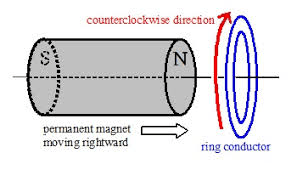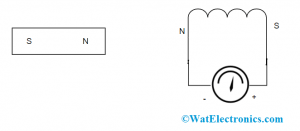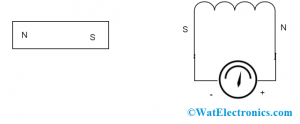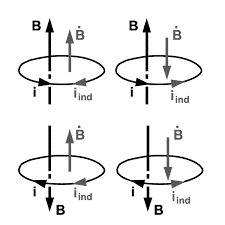Lenz’s law was initially proposed by Heinrich Friedrich Lenz where his entire career was completely contributed to physics and chemistry. His initial observation was on the Peltier effect which means metals conductivity nature and change in the value of electrical resistance in correspondence to temperature. Then the research of Lenz moved to electrical conductivity and discovered the Joule effect which was the study regarding electrical variations independence were directed to the announcement of Lenz’s law in the year 1834. This way, the approach contributed to the development of Lenz law which makes the possibility of knowing direction and vibration developed by the change in energy flow. This article shows a clear description of Lenz law, its formula, significance, and applications.
What is Lenz’s Law?
Lenz’s law electromagnetic induction defines that the current direction developed in the conductor by varying the magnetic field (which is the magnetic field developed by the induced current) is in opposition to the initial varying magnetic field that developed it. The current flow direction is represented using Fleming’s right-hand principle.
It seems to be difficult to initially understand the concept of Lenz’s law, to make this easy let us consider the below example.
When the simulation of current is done by the magnetic field, then the magnetic field that this simulated current produced will generate its own magnetic field. And the generated magnetic field will oppose the magnetic field which initially created it.

Lenz’s Law Principle
This is the qualitative principle that indicates the simulated current direction but explains nothing related to the magnitude. Lenz’s law states the path of multiple effects in electromagnetism like the path of voltage simulated in the inductor or wire through varying current, or the pulling force of eddy currents applied on the moving things in the magnetic field.
The below example clearly explains the scenario where when the magnetic field gets increased, the simulated magnetic field will function in the opposite way to it. Whereas when the magnetic field gets decreased, the simulated magnetic field also acts in the opposite way to it. But here, the opposite way corresponds that it is operating in order the enhance the field as because it is resisting the declining rate of change.
This law is mainly dependent on Faraday’s principle of induction. As per this principle, the varying magnetic field will stimulate the current to pass through the conductor. Lenz’s principle states that the path of simulated current contradicts the actual varying magnetic field which generated it. This scenario can be represented by a formula and it is shown below:
Є = -(dФB/dt)
The variation in the magnetic field might be because of the variation in the magnetic field strength either by changing the magnet close or far from the coil or else changing the coil’s position in correspondence to a magnetic field. It can also be stated that the magnitude of the EMF which is simulated in the circuit will have a directly proportional relationship to the flux variation rate.
Formula
Lenz’s law defines that when there is a generation of EMF because of variation in the magnetic field, then the polarization of the simulated EMF is in the way that it generates a simulated current where its magnetic field contradicts the initial varying magnetic field that generated it. And the Lenz’s law formula is given by:
Є = -N (dФB/dt)
Where ‘Є’ correspond to simulated EMF
‘dФB’ corresponds to a varying magnetic field
And ‘N’ signifies coil turns.
The negative sign in the formula states that the simulated EMF and the varying magnetic field have contradicting signs.
Lenz’s Law and Conservation of Energy
To comply with the principle of conservation of energy, the simulated current path through Lenz’s law should generate a magnetic field that contradicts the magnetic field which produced it. This law is the effect of the principle of conservation of energy.
When the magnetic field generated by the simulated current is similar to that of the field that created it, then both the fields will merge and develops an increased magnetic field. This increased field will generate another simulated current internal to the conductor that is double the magnitude of the actual simulated current. Again, this produces another simulated current and this process continues.
So, it can be stated that Lenz’s law itself generates the simulated current which contradicts the field which produced it – so that one can conclude by an infinite positive feedback loop thus blocking the conservation of energy.
Lenz’s law also complies with the Newtons’ third principle. As per this when the simulated current generates a magnetic field that is the same and in contradiction to the path of the magnetic field that produced it, then only it holds the ability to repel the variation in the magnetic field in that location.
Explain Lenz’s Law
In order to clearly understand the phenomenon behind Lenz’s law, consider the below two situations.
Situation 1: When the magnetic is moving close to the coil.
When the magnet’s north pole comes close to the coil, then the flux that connects to the coil will also be increased. As per Faraday’s principle, when there is variation in flux and EMF then there happens simulation of current in the coil and this generates its own magnetic field.

Understanding of Lenz’s Law – Case 1
And as per Lenz’s law, the magnetic field will itself contradicts or else opposes the flux increment across the coil and it is feasible only when the coil gains north polarity is because the same kind of poles repulses each other. By knowing the coil’s magnetic polarity, the path of the simulated current can also be known. Here, the direction of the current will be in an anticlockwise direction.
Situation 2: When the magnetic is moving far away from the coil.
When the magnet’s north pole is moving away from the coil, then the flux that connects to the coil will be decreased. As per Faraday’s principle, when there is variation in flux and EMF then there happens simulation of current in the coil and this generates its own magnetic field.

Understanding of Lenz Law – Case 2
And as per Lenz’s law, the magnetic field will itself contradicts or else opposes the decreased flux across the coil and it is feasible only when the coil gains south polarity as because non-identical poles attract each other. By knowing the coil’s magnetic polarity, the path of the simulated current can also be known. Here, the direction of the current will be in a clockwise direction.
This is considered as the detailed significance of Lenz’s law.
It is possible to know the directions of the current or magnetic field through the right-hand thumb principle. When the right-hand fingers are positioned all across the wire, then the direction of the thumb corresponds to the direction of current flow and the direction of curled fingers depicts the magnetic field direction generated by the wire.
Through this right-hand thumb rule, Lenz’s law is defined as:
When the magnetic flux Ф that connects to the coil increases, then the current direction is in the way that it contradicts the flux increment and so the simulated current will generate its flux in the direction.

Right-Hand Thumb Rule
When the magnetic flux Ф that connects to the coil decreases, then the current direction is in the way that it is similar to the direction of decreasing flux and so the simulated current will generate its flux in the direction as displayed in the below picture.
Problem Solving Procedure
The problems that are to be resolved through Lenz’s law can be easily resolved by following the below steps:
- Know the question and have a clear picture of what has to be determined.
- Find out the magnetic field path
- Know whether the rate of flux is declining or increasing
- Now, find the path of the simulated magnetic field. This contradicts the variation in flux either by subtracting or combining to the actual field
- Calculate the simulated current which generates a simulated magnetic field
- The path of the simulated EMF will now trigger current in this path and might be stated as the current that is developing from the positive edge of the EMF and getting back to the negative edge.
Applications
These are the few applications of Len’z law:
- Through this law, the theory of accumulated magnetic energy in the inductor is known. When the source EMF is linked through the inductor, then there will be current flow across it. The back EMF will contradict the current increment across the inductor. So, to induce current flow, there has to be another peripheral EMF source that defeats the contradiction. This is accomplished by the EMF which is accumulated in the inductor and it also can be regained after the removal of the peripheral EMF source from the circuit.
- This law defines that simulated EMF and the variation in flux will have dissimilar signs and this shows a physical analysis of the selection of signs in Faraday’s induction principle.
- Lenz law is also applicable for electric generators. When there is a simulation of current in the generator, this contradicts it and triggers generator rotation and so the device needs additional mechanical energy. This also offers back EMF when the devices are electric motors.
- Applicable in electromagnetic braking and induction cookware.
- Used in eddy current equalizers and eddy current dynamometers.
- Utilized microphones, braking equipment in train and AC generators.
- The devices that work on Lenz’s law can also be used in card readers.
Please refer to this link to know more about Gauss Law, Snell’s Law & Flux meter.
know more about Gauss Law MCQs.
This is all about the concept of Lenz’s law. This article has provided comprehensive information about Lenz’s law principle, its formula, conservation of energy, significance, and applications. It is even more crucial to also know about a few more examples of Lenz’s law in real-life applications.